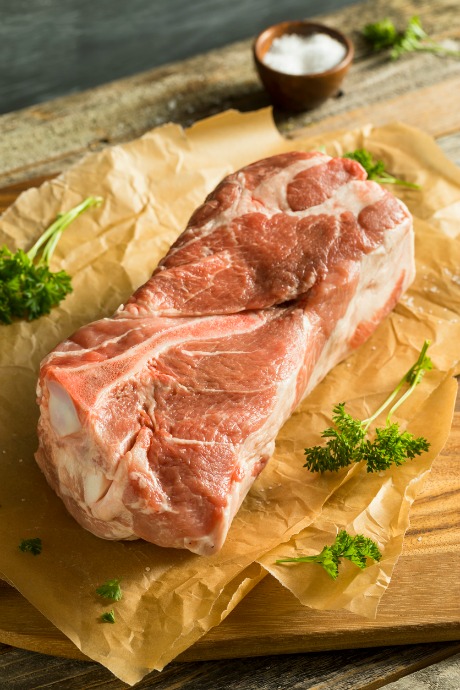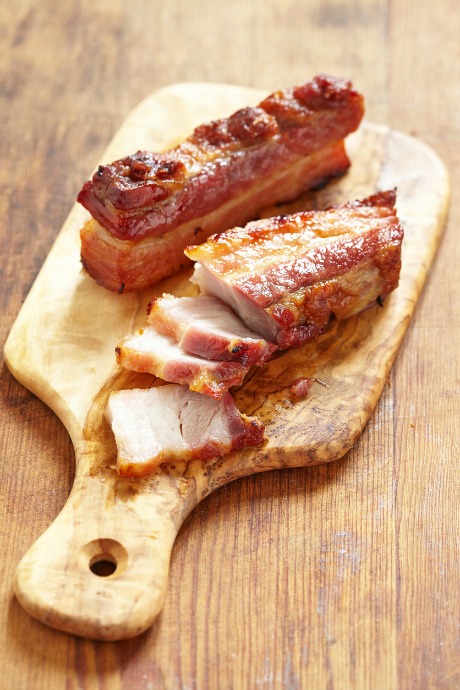At the Meat Market: Cuts of Pork
Posted by April on Jul 26th 2018
Marketed as “the other white meat,” pork is a delicious alternative to beef. From pork chops and pork tenderloin to bacon and ham, pork offers a wide range of flavors and textures. Its versatility and wide availability make pork a perennial favorite at the grocery store and at the dinner table.
Before you head to the butcher’s cooler at the market, be sure you know which cut of pork will work for your recipe. In this post, we'll cover the various cuts, what part of the pig they come from, and how to cook each one.
Cuts of Pork: Shoulder
The pork shoulder is the front portion of the pig consisting of the front legs and shoulders. When cut into pork roasts, the upper part of the shoulder is called pork butt or Boston butt. Because pigs use their front legs quite a bit, the pork shoulder is typically a rather tough cut. That means “low and slow” is the best way to cook pork shoulder. Despite its toughness, pork shoulder is rich in fat and has great flavor. It's the cut used in pulled pork barbecue.

When the very top portion of the shoulder is sliced into steaks, they can be fairly tender and suitable for grilling. However, other shoulder steaks aren't as tender and should be cooked for longer periods of time or chopped into smaller pieces for stews and soups.
The picnic shoulder is the lower portion of the shoulder and top of the leg. It is often cured and smoked for hams, but the entire picnic shoulder can also be ground into sausage.
Cuts of Pork: Loin
The pork loin is the butcher’s name for meat cut from the pig’s back. Pork tenderloin is a lean and tender cut of meat. Because it is so lean, it can be easy to dry out the meat, so be careful when you cook it. Usually, pork tenderloins are packaged in pairs, often with flavoring added.
Chops cut from the rib section of the pork loin are perfect for pan frying or grilling. Most boneless pork chops that you find in stores are cut from this section of meat.
Baby back ribs are also cut from the pork loin, but from the section closest to the backbone. These ribs are especially tender and delicious. Like pork tenderloin, baby back ribs need special attention on the grill to ensure they don’t dry out and become tough.
Center cut loin roasts, boneless pork loin, and center cut rib roasts are all flavorful choices. These cuts do have plenty of fat, but that also means they have lots of flavor. Roast these cuts of pork to preserve the texture and flavor of the meat.
Cuts of Pork: Belly
Much of the pork belly goes into bacon, one of the most popular cuts of pork. The pork belly is sliced and cured into bacon or other cured meats like pancetta.

At specialty butchers, you can sometimes find uncured pork belly roasts. This cut of pork boasts copious fat, but when it's roasted, it practically melts in your mouth. Alternately, you can slice uncured pork belly thin and fry it.
Cuts of Pork: Ham
Hams come from the back legs of a pig. Hams can be fresh (uncured), smoked, or cured. When hams are cured, they are soaked in a solution containing salt, preservatives, and flavorings to give the pork the traditional “ham” flavor. Often, cured and smoked hams are precooked and simply need to be reheated, but check the label to make sure. The ham hock is from the lower portion of the ham. It is easy to find in the southern United States, where it is used for flavoring collard greens and white beans.
Cuts of Pork: Other Miscellaneous Bits
Sausage is ground from other odd bits of pork that come off when trimming out a carcass. Pigs feet are often pickled and you can find them in large jars in the southern United States. Mexican menudo also features pork feet. Pork jowl comes from the neck of a pig. Sometimes it’s ground into sausage, but other times you can find it cured. You can use pork jowl to season things like baked beans. Even the skin of a pig is used for food. Pork skins are fried and salted, making crunchy snacks called pork rinds that many people love.

No matter what cuts of pork you choose, they should be firm and pink. If you can find and afford it, seek out pasture-raised pork available through specialty markets. These pigs are raised on pasture the way nature intended. The flavor and complexity of pastured pork can’t be beaten!
No matter your budget or personal taste, there is a cut of pork your family can enjoy on a regular basis.
As an avid farmer, gardener, and cook, April Freeman is an expert in the food production process. She raises pigs, chickens, beef cattle, and grows a wide variety of vegetables and fruits on her family farm in Tennessee. Learn more about April’s firsthand experience with farm-fresh food on her blog, Feeding My Family.

